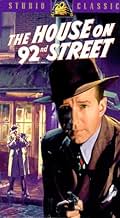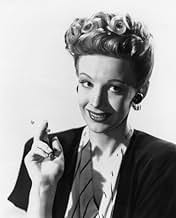IMDb RATING
6.6/10
3.4K
YOUR RATING
Bill Dietrich becomes a double agent for the F.B.I. in a German spy ring.Bill Dietrich becomes a double agent for the F.B.I. in a German spy ring.Bill Dietrich becomes a double agent for the F.B.I. in a German spy ring.
- Won 1 Oscar
- 2 wins total
William Post Jr.
- Walker
- (as William Post)
William Adams
- Customs Officer
- (uncredited)
Frieda Altman
- Saboteur
- (uncredited)
William Beach
- Saboteur
- (uncredited)
Carl Benson
- German Spy Trainee
- (uncredited)
Hamilton Benz
- Saboteur
- (uncredited)
Storyline
Did you know
- TriviaThe movie deals with the theft by German spies of the fictional "Process 97", a secret formula which, the narrator tells us, "was crucial to the development of the atomic bomb." The movie was released on September 10, 1945, only a month after the atomic bombs had been dropped on Japan, and barely a week after Japan's formal surrender. While making the film, the actors and Director Henry Hathaway did not know that the atomic bomb existed, nor that it would be incorporated as a story element in the movie. (None of the actors in the film mentioned the atomic bomb.) However, co-Director and Producer Louis De Rochemont (who produced the "March of Time" newsreel films) and Narrator Reed Hadley were involved in producing government films on the development of the atomic bomb. (Hadley was present at the final test of the bomb in Los Alamos, New Mexico, in July, 1945.) After the bomb was dropped on Hiroshima, Hadley and Screenwriter John Monks, Jr. hastily wrote some additional voice-over narration linking "Process 97" to the atomic bomb, and Rochemont inserted it into the picture in time for the film's quick release.
- GoofsThe description of a one-way mirror as an "X-ray" mirror at the beginning is nonsense. A one-way mirror is in fact merely a partially-silvered mirror. It becomes "one-way" by virtue of different lighting on either side - one side dimly lit, the other brightly lit. From the side that's brightly lit, it appears to be a normal mirror because the reflection washes out any light coming through from the dim side. But from within the dim side, everything on the bright side is readily visible because the light coming through predominates over the reflection seen from the dim side.
- Quotes
Agent George A. Briggs: We know all about you, Roper. We've traced you to the day you were born. We even know the approximate day you will die.
- Crazy creditsOpening credits are shown as someone flipping through the pages of a file.
- ConnectionsReferenced in 23 Paces to Baker Street (1956)
- SoundtracksTra-La-La-La
(uncredited)
Music by Harry Warren
Played as background music at the talent agent's office
Featured review
"The House on 92nd Street" is a 1945 film about the FBI's attempts to break up a spy ring during the war. A young man, William Dietrich (William Eythe), who has been recruited by the Nazis as a spy, informs the FBI of this and becomes their mole inside the organization. One of Dietrich's goals is to get the identity of the mysterious "Mr. Christopher" who gives all of the orders.
This is a black and white film with strong narration that probably had a great impact at the time of its release. Though the machinery used in the movie looks archaic now, back then it must have been fascinating for an audience to watch and seemed very high-tech. Plus some of the material being transmitted had to do with the top-secret atom bomb, which at the time of the film, had just been dropped.
The cast is small, consisting of Eythe, Lloyd Nolan, Leo G. Carroll, Signe Hasso, Gene Lockhart, and Lydia St. Clair. They're all solid. For a change, the women, Hasso and St. Clair, have the strongest roles in the film, and they give striking performances. Eythe was getting the big star build-up at 20th Century Fox. Since it was wartime, he could have made a place for himself at the studio the way that Dana Andrews did. However, when gay rumors reached Darryl Zanuck, Eythe's path became a rocky one, leading nowhere, as the studio continually demoted him and eventually got rid of him.
Well worth seeing.
This is a black and white film with strong narration that probably had a great impact at the time of its release. Though the machinery used in the movie looks archaic now, back then it must have been fascinating for an audience to watch and seemed very high-tech. Plus some of the material being transmitted had to do with the top-secret atom bomb, which at the time of the film, had just been dropped.
The cast is small, consisting of Eythe, Lloyd Nolan, Leo G. Carroll, Signe Hasso, Gene Lockhart, and Lydia St. Clair. They're all solid. For a change, the women, Hasso and St. Clair, have the strongest roles in the film, and they give striking performances. Eythe was getting the big star build-up at 20th Century Fox. Since it was wartime, he could have made a place for himself at the studio the way that Dana Andrews did. However, when gay rumors reached Darryl Zanuck, Eythe's path became a rocky one, leading nowhere, as the studio continually demoted him and eventually got rid of him.
Well worth seeing.
- How long is The House on 92nd Street?Powered by Alexa
Details
- Release date
- Country of origin
- Languages
- Also known as
- Hamburg Seven, Seven, Seven
- Filming locations
- Hamburg, Germany(second unit)
- Production company
- See more company credits at IMDbPro
Box office
- Gross US & Canada
- $2,500,000
- Runtime1 hour 28 minutes
- Color
- Aspect ratio
- 1.37 : 1
Contribute to this page
Suggest an edit or add missing content

Top Gap
By what name was The House on 92nd Street (1945) officially released in India in English?
Answer





























